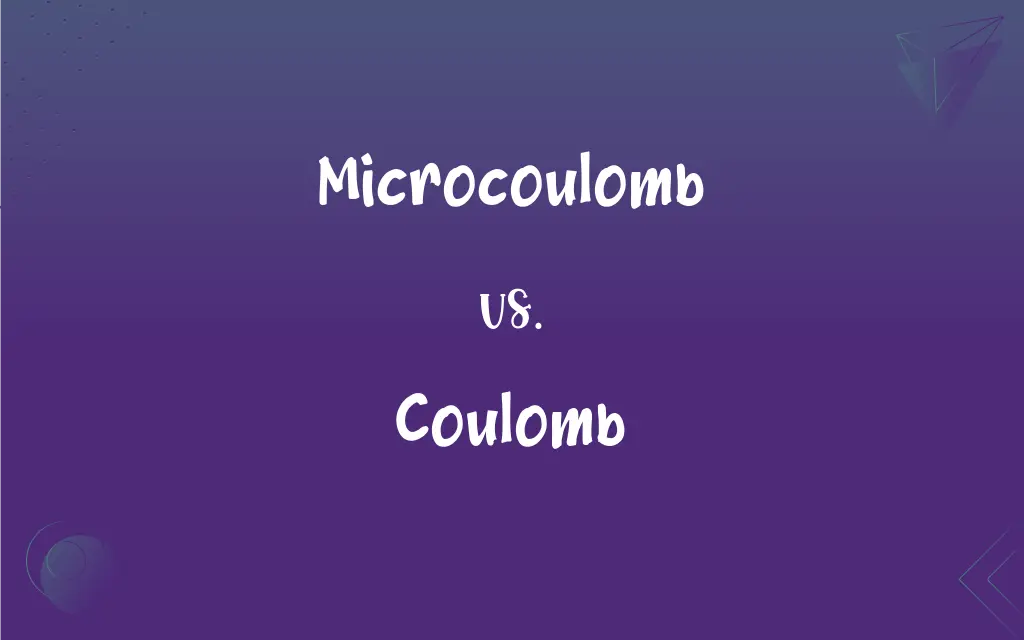Microcoulomb vs. Coulomb: What's the Difference?
By Harlon Moss & Janet White || Updated on May 28, 2024
Microcoulomb (µC) is a unit of electric charge equal to one millionth of a coulomb, whereas a coulomb (C) is the standard SI unit of electric charge.

Key Differences
A microcoulomb (µC) represents a very small amount of electric charge, precisely one millionth of a coulomb. A coulomb (C), on the other hand, is the standard SI unit for electric charge. It is a much larger unit, equivalent to the charge transported by a constant current of one ampere in one second.
Microcoulombs are particularly useful in scientific research and applications requiring high precision. For example, measuring the charge in tiny capacitors or the output of small sensors often involves microcoulombs due to the tiny amounts of charge involved. While coulombs are essential in describing and calculating electric phenomena on a larger scale, such as the charge storage in capacitors or the amount of charge transferred by electric currents over time. They provide a broader understanding of electric systems and are critical in engineering and physics.
Microcoulombs provide a more granular perspective, essential for high-precision and small-scale applications. They allow for detailed and accurate measurements at the micro level, which are crucial for advancements in microelectronics and nanotechnology. Conversely, coulombs offer a macro-level view, facilitating the design and analysis of electrical systems and components on a larger scale. Their usage is vital for practical applications in everyday electrical and electronic devices.
Comparison Chart
Definition
One millionth of a coulomb
Standard SI unit of electric charge
Symbol
µC
C
ADVERTISEMENT
Magnitude
1 µC = 10^-6 C
1 C
Usage
Small-scale, high-precision applications
Large-scale, general electrical use
Example Application
Microelectronics, sensors
Batteries, capacitors
Microcoulomb and Coulomb Definitions
Microcoulomb
A unit of electric charge equal to one millionth of a coulomb.
The sensor emitted a charge of 3 microcoulombs.
Coulomb
The SI unit of electric charge, representing a large quantity.
The battery stored 5 coulombs of charge.
ADVERTISEMENT
Microcoulomb
Used to measure very small amounts of electric charge.
The microcoulomb reading was crucial for the experiment.
Coulomb
Used for measuring larger amounts of electric charge.
The capacitor held a charge of 2 coulombs.
Microcoulomb
Common in microelectronics and precision instruments.
The microcoulomb scale was necessary for accurate readings.
Coulomb
Standard unit for electric charge in physics and engineering.
The electric current was 1 ampere per coulomb.
Microcoulomb
Symbolized as µC.
The device measured the output in µC.
Coulomb
Symbolized as C.
The total charge was recorded as 10 C.
Microcoulomb
Helps in high-precision electric charge measurements.
The microcoulomb meter provided exact charge data.
Coulomb
Essential for describing and calculating electric phenomena.
The device's capacity was rated in coulombs.
Microcoulomb
A measure of electrical quantity, the millionth part of one coulomb.
Coulomb
The basic unit of electric charge, equal to the quantity of charge transferred in one second by a steady current of one ampere, and equivalent to 6.2415 × 1018 elementary charges, where one elementary charge is the charge of a proton or the negative of the charge of an electron. A coulomb's value in the International System differs very slightly from that in the meter-kilogram-second-ampere system of units. See Table at measurement.
Microcoulomb
A measure of electrical quantity; the millionth part of one coulomb.
Coulomb
Of or relating to the Coulomb force.
Coulomb
In the International System of Units, the derived unit of electric charge; the amount of electric charge carried by a current of 1 ampere flowing for 1 second. Symbol: C
He is charged up with enough coulombs to make his hair stand on end.
Coulomb
The standard unit of quantity in electrical measurements. It is the quantity of electricity conveyed in one second by the current produced by an electro-motive force of one volt acting in a circuit having a resistance of one ohm, or the quantity transferred by one ampère in one second. Formerly called weber.
Coulomb
A unit of electrical charge equal to the amount of charge transferred by a current of 1 ampere in 1 second
Coulomb
French physicist famous for his discoveries in the field of electricity and magnetism; formulated Coulomb's Law (1736-1806)
FAQs
How many microcoulombs are in a coulomb?
There are 1,000,000 microcoulombs in a coulomb.
When is it appropriate to use microcoulombs?
Microcoulombs are used in high-precision, small-scale applications like microelectronics and sensors.
What is the symbol for microcoulomb?
The symbol for microcoulomb is µC.
What is a microcoulomb?
A microcoulomb is a unit of electric charge equal to one millionth of a coulomb.
In what applications are coulombs typically used?
Coulombs are used in applications involving larger amounts of charge, such as batteries and capacitors.
Can microcoulombs be converted to coulombs?
Yes, microcoulombs can be converted to coulombs by dividing by one million.
What is a practical example of using microcoulombs?
Measuring the output of a small sensor in microcoulombs is a practical example.
How is the concept of coulombs used in physics?
Coulombs are used to quantify electric charge in physics, fundamental to understanding electric fields and forces.
How does a coulomb compare to a microcoulomb in magnitude?
A coulomb is one million times larger than a microcoulomb.
What is a coulomb?
A coulomb is the standard SI unit of electric charge.
Why are microcoulombs important in electronics?
Microcoulombs are important for precise measurements in microelectronics where charge amounts are very small.
What does 1 microcoulomb represent?
1 microcoulomb represents one millionth of a coulomb of electric charge.
How is charge measured in microcoulombs?
Charge is measured in microcoulombs using sensitive instruments designed for small-scale measurements.
What is the symbol for coulomb?
The symbol for coulomb is C.
Is 1 coulomb a large or small amount of charge?
1 coulomb is a relatively large amount of charge compared to everyday small-scale electric charges.
What units are smaller than microcoulombs?
Picocoulombs (pC), which are one trillionth of a coulomb, are smaller units than microcoulombs.
Are microcoulombs used in everyday electrical applications?
Microcoulombs are not commonly used in everyday applications but are critical in specialized scientific and engineering contexts.
What is the significance of 1 coulomb in electrical engineering?
1 coulomb is significant in electrical engineering as it represents a substantial amount of charge for practical circuit design and analysis.
How are large electric charges typically expressed?
Large electric charges are typically expressed in coulombs.
How does using coulombs facilitate understanding of electrical systems?
Using coulombs facilitates understanding of electrical systems by providing a standard unit for quantifying electric charge, essential for calculations and design.
About Author
Written by
Harlon MossHarlon is a seasoned quality moderator and accomplished content writer for Difference Wiki. An alumnus of the prestigious University of California, he earned his degree in Computer Science. Leveraging his academic background, Harlon brings a meticulous and informed perspective to his work, ensuring content accuracy and excellence.
Co-written by
Janet WhiteJanet White has been an esteemed writer and blogger for Difference Wiki. Holding a Master's degree in Science and Medical Journalism from the prestigious Boston University, she has consistently demonstrated her expertise and passion for her field. When she's not immersed in her work, Janet relishes her time exercising, delving into a good book, and cherishing moments with friends and family.































































